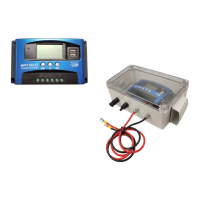Rev 20200515
Page 5
Innovative Renewable Energy Solutions
B. Voltage drop, to avoid low voltage / high current issues.
Voltage drop is a phenomenon that can aect low voltage (under 60V) systems quite a bit. We
recommend checking with the voltage drop calculator from calculator.net found here. One of the biggest
problems with having a voltage drop too low, is that it proporonally increases the current of the system,
which can have a tendency to overheat wiring or components. You can read more about this on our blog.
As a general rule of thumb, 2% voltage drop is considered good, and 3% voltage drop is considered
acceptable.
When in doubt, bigger wire is beer.
Note: the largest praccal size wire that can be used in this charge controller’s terminals is 10AWG.
10AWG silicone insulated nned copper wire is rated for 140.6A maximum.
3. This charge controller is suitable for charging lead acid 13.7V nominal baeries (deep cycle, AGM, Gel,
SLA) as well as Lithium Iron Phosphate (LiFePO4) 4S 12.8V nominal baeries.
It can be used to charge Nickel Oxide based lithium baeries, but it isn't recommended because you
won’t be able to use the full voltage range of these baeries.
How does it work?
MPPT is a fascinang technology. MPPT stands for Maximum power point tracking. Basically, it is a
charging control technique that determines the point at which a solar panel’s maximum voltage and
current (thus, power) can be used to charge your baery. A visual graph of a typical solar panel is shown
below. The line which follows the “knee” of the curves indicates the maximum power point. As you can
see, the maximum power point will change depending on the amount of sunlight. The ability of this
charge controller to adapt and harvest the maximum amount of power with any given amount of sunlight
is what makes it almost 99% ecient. You can read more about MPPT here.
DON’T BELIEVE US??
Perform your own precise tests using our Smart Tech
Power Meter. Designed specically for wind and solar,
our Smart Tech Power Meter is perfect for all of your
tesng needs. Easy pairing through your standard WiFi
router or phone's hotspot, you can view the measured
voltage, current (amps) and the power output (Was).
More info here

